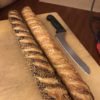Pittsburgh restaurant Conflict Kitchen has a mission beyond just serving delicious meals: they seek to educate Americans about nations with which the US has conflicts, through the experience of food.
Taking on one country at a time, they explore the culinary heritage of places like Iran, Venezuela, and Afghanistan, with the hope that, by sampling some local flavor, diners will gain a little insight into these far-off places. And, to add to the educational element, they wrap their take-away fare in paper printed with facts about the focus country.
Currently, Conflict Kitchen is cooking up Cuban dishes – just not the one that might come to mind. Rico met with Culinary Director Robert Sayre to talk about researching the menu.

Rico Gagliano: What is the classic Cuban sandwich?
Robert Sayre: Ham, Swiss cheese, pickles, mustard. It’s probably the number one item that Americans associate with Cuban food – but in Cuba, at least in Havana when we spent about ten days there, we didn’t once see one from any of the street food stands that we saw.
Rico Gagliano: Where does that sandwich come from?
Robert Sayre: I guess historically it does come from Cuba, but where it lives now is basically in the Florida Cuban ex-pat community.
Rico Gagliano: All the people that made those sandwiches basically moved to the United States?
Robert Sayre: There’s that, and then there’s a matter in Cuba too of access to ingredients, and the economics of being able to afford a sandwich like that. You have to have the roast pork, you have to have the bread, you have to have the cheese.
For the most part, the meals that we saw your everyday Cuban eating weren’t as elaborate as that.
Rico Gagliano: So give me an example. What was maybe the most ubiquitous dish there?
Robert Sayre:
One of our main questions when we’re interviewing people in the countries we visit we always ask, “What dish is the most emblematic of your country?”And it was almost universal answer in Cuba was congris, rice and beans.Several people mentioned that sometimes when they have a dinner party or a get together with friends they make it together. Somebody will be like, “I have the garlic.” Somebody else will say, “I’ve got a bag of green peppers,” and somebody will be, “I’ll bring the rice,” and then they will sit together and chat while they cook and make this dish all together and then eat it.
Rico Gagliano: What was the most unusual thing you ran into that maybe you weren’t expecting or hadn’t heard of?
Robert Sayre: I guess some of the things we weren’t quite expecting were we ate in a few of the paladares, which is kind of an in-home private restaurant. Some of those have actually pretty sophisticated dishes. We ate lobster poached in papaya and vanilla bean.
So there are some chefs that are trying to be creative with what they have access to, the ingredients they have there, and this growing private restaurant scene, whereas previously all the restaurants were state-owned.
Rico Gagliano: Now, I notice you did not have lobster and vanilla bean, etc. What’s your favorite item on the menu?
Robert Sayre: Besides the beans and rice? The other emblematic flavor of Cuba is the mojo marinade and sauce which is bitter orange, garlic, oregano, cumin.
We use that on a variety of dishes on our menu. We use it as the dipping sauce with the tostones which are the fried plantains. We use it to marinate the pork which we then slow roast.
You can marinate anything in it and it ends up tasting pretty delicious.
Rico Gagliano: Is it true that while you were in Cuba you actually paid a visit to the North Korean embassy?
Robert Sayre: Yes. With the nature of our project we’re always aware of the countries that are on our short list for future versions that we’re going to do. North Korea, of course, is an obvious choice.
When we were in Cuba we were walking down the street and we just notice all these posters of North Korean troops or soldiers keeping a look-out over the mountains, there are all these banners of the flag of North Korea and the great leader.
So we come around to the front of the building and it’s of course, the North Korean embassy, technically North Korean soil, and this may be our only chance to get onto North Korean soil.
Rico Gagliano: Unlike Cuba, it’s going to be next to impossible to actually go to the real North Korea and check it out.
Robert Sayre: We’re going to South Korea soon actually to meet with some North Korean refugee groups, but North Korea itself is a little more complicated. We rang the doorbell, a guy comes out to answer the door wearing flip flops and Jams and a Bermuda shirt. Turns out he’s the undersecretary. He’s not some guy that works on the grounds.
Rico Gagliano: He’s gone native, basically.
Robert Sayre:
I guess when they leave North Korea, that’s probably a pretty plum assignment, to leave North Korea and get to hang out in Havana.
Rico Gagliano: I imagine him kicking back with some sort of cocktail and a pineapple.
Robert Sayre: That did not look out of the question. Past the outer walls there’s probably just a series of hammocks.
Rico Gagliano: Did you get any recipes from him?
Robert Sayre: We spoke to him a little bit about food and what he made a very clear point of saying was “Korean food is Korean food.” He’s like, “Our country has been split into two for 60 years, but we’ve been one culture for thousands of years before that.” That’s what we found through our own research as well.
Historically, the cuisine is pretty similar. The only differences are in North Korea it’s colder and more mountainous. You’re more likely to have things like sweet potato and buckwheat noodles versus rice noodles. Differences due to climate.
Rico Gagliano: All right, I’ll come back for the Korean food. But can I try the Cuban?
Robert Sayre: Sure.
Rico Gagliano: We’re now standing at the take-out window of Conflict Kitchen. What are we going to eat here?
Robert Sayre: We serve basically our larger plates in cajitas which is basically a little box. You will see these on the streets of Cuba; we did see these in Havana.
Rico Gagliano: Kind of a little take-out brown box.
Robert Sayre: Yeah, just a take-out brown box lunch basically, with all your food right in there. You have the black beans and rice, some of the yucca con mojo.
Rico Gagliano: The yucca’s kind of a root vegetable.
Robert Sayre: It’s a root vegetable. It’s also known as cassava, a little sweeter than potato. Definitely starchier, very gummy. It’s also where they get tapioca starch from.
Rico Gagliano: That’s where everybody gets tapioca starch from?
Robert Sayre: Yeah, tapioca is from cassava root.
Rico Gagliano: I’m actually going to start with that because it’s actually morning time and I could pretend that they’re home fries a little bit. Although they’re not actually fried; it looks like these are boiled, actually.
Robert Sayre: Yucca is boiled and then you cook some onions and the mojo sauce with some oil and then heap the boiled yucca back up in that sauce.
Rico Gagliano: Here we go. Oh, that’s delicious. I’m getting the bitter orange which has a kind of, because it’s bitter, it has an almost a lemony character to it.
Robert Sayre: It’s a much more sour orange than we’re used to consuming here. It has that orange flavor to it, but not nearly the sweetness.
Rico Gagliano: I really love how tart it is and right now that’s kind of the flavor profile of the day in American cuisine, is kind of sour, sweet and sour, and it’s really great.
I wanted to ask you, I saw that one of your upcoming menus is going to be Palestinian and Israeli food on one menu, is that right?
Robert Sayre: That’s one of the conflicts that we’re starting to look at for a future menu.
One of the ideas we’ve tossed around too is doing a Palestinian side of the menu and an Israeli side of the menu but then having them have exactly the same food on them.Because historically, they are from the same region, they eat many of the same food items.
Rico Gagliano: So this menu goes, hopefully so goes the world.


